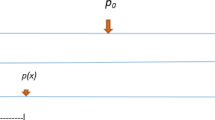Abstract
The normal human heart is a strong muscular two-stage pump which pumps continuously through the circulatory system. It is a four-chambered pump that controls blood through a series of valves in one direction. Blood flow through a blood vessel, such as vein and artery, can be modeled by Poiseuille’s law which establishes a relationship between velocity of blood and the radius of the vessel. Our goal here is to solve the differential equations numerically by replacing with algebraic equations to obtain approximate solutions of velocity. We will walk through the development of the simulation procedure to visualize how blood flows in steady state. At the end of the chapter, students will be able to do projects on their own to visualize the flow simulation in one dimension.
Access this chapter
Tax calculation will be finalised at checkout
Purchases are for personal use only
Similar content being viewed by others
Bibliography
Michael A. Calter, Paul A. Calter, Paul Wraight, Sarah White; Technical Mathematics with Calculus, John Wiley & Sons, Inc., 2011.
Paul Peter Urone, Roger Hinrichs; College Physics, Chapter 12 OpenStax, Houston Texas, 2012.
D. J. Acheson; Elementary Fluid Dynamics, Oxford University Press Inc., 1990.
J. D. Anderson; Computational Fluid Dynamics: The Basics with Applications, McGraw-Hill, Singapore.
J. H. Ferziger, M. Perić, R. L. Street; Computational Methods for Fluid Dynamics, 4ed, Springer Nature Switzerland, 2002.
Cleve B. Moler; Numerical Computing with MATLAB, SIAM, 2004.
Fielding H. Garrison; An Introduction to the History of Medicine, 3ed, W. B. Saunders Compan, Pp 495-496, 1922.
Andras Gedeon; Science and Technology in Medicine Springer, 2006.
Nico Westerhof, Nikos Stergiopulos, Mark I. M. Noble; Snapshots of Hemodynamics: An aid for clinical research and graduate education, Springer, 2005.
S. P. Sutera, R. Skalak; The History of Poiseuille’s Law, Annual Review of Fluid Mechanics, Vol. 25:1-20, 1993.
Poiseuille, Jean Léonard Marie, encyclopedia.com, https://www.encyclopedia.com/science/dictionaries-thesauruses-pictures-and-press-releases/poiseuille-jean-leonard-marie.
Glenn Elert; The Physics of Hypertextbook. https://physics.info/viscosity/
Richard E. Klabunde; Cardiovascular Physiology Concepts. 3rd ed., Wolters Kluwer, 2021. https://www.cvphysiology.com/
Frank M. White; Fluid mechanics, 7ed, McGraw-Hill, Inc. 2009.
Elaine N. Marieb; Human Anatomy & Physiology, 6ed, Pearson, 2004.
James Stewart, Daniel Clegg, Saleem Watson; Calculus, 9ed, Cengage, 2021.
Wikipedia; Hemorheology. https://en.wikipedia.org/wiki/Hemorheology.
Sapna Ratan Shah; Significance of Aspirin on Blood Flow to Prevent Blood Clotting through Inclined Multi-Stenosed Artery. Letters in Health and Biological Sciences, 2017. https://doi.org/10.15436/2475-6245.17.018
Prabook Jean Léonard Marie Poiseuille, mathematician, physicist, physiologist, scientist. https://prabook.com/web/jean.poiseuille/3758036
Unregulated artery cell growth may drive atherosclerosis, Stanford Medicine research shows, Stanford Medicine, News Center, June 19, 2020. https://med.stanford.edu/news/all-news/2020/06/unregulated-artery-cell-growth-may-drive-atherosclerosis.html.
Source, Source: https://www.medicinenet.com/image-collection/carotid_arteries_disease_picture/picture.htm
Author information
Authors and Affiliations
Corresponding author
Editor information
Editors and Affiliations
Appendix
Appendix




Rights and permissions
Copyright information
© 2022 The Author(s), under exclusive license to Springer Nature Switzerland AG
About this chapter
Cite this chapter
Pati, A.N., Ladipo, K.O. (2022). Numerical Simulation of Arterial Blood Flow. In: Goldwyn, E.E., Ganzell, S., Wootton, A. (eds) Mathematics Research for the Beginning Student, Volume 2. Foundations for Undergraduate Research in Mathematics. Birkhäuser, Cham. https://doi.org/10.1007/978-3-031-08564-2_2
Download citation
DOI: https://doi.org/10.1007/978-3-031-08564-2_2
Published:
Publisher Name: Birkhäuser, Cham
Print ISBN: 978-3-031-08563-5
Online ISBN: 978-3-031-08564-2
eBook Packages: Mathematics and StatisticsMathematics and Statistics (R0)




